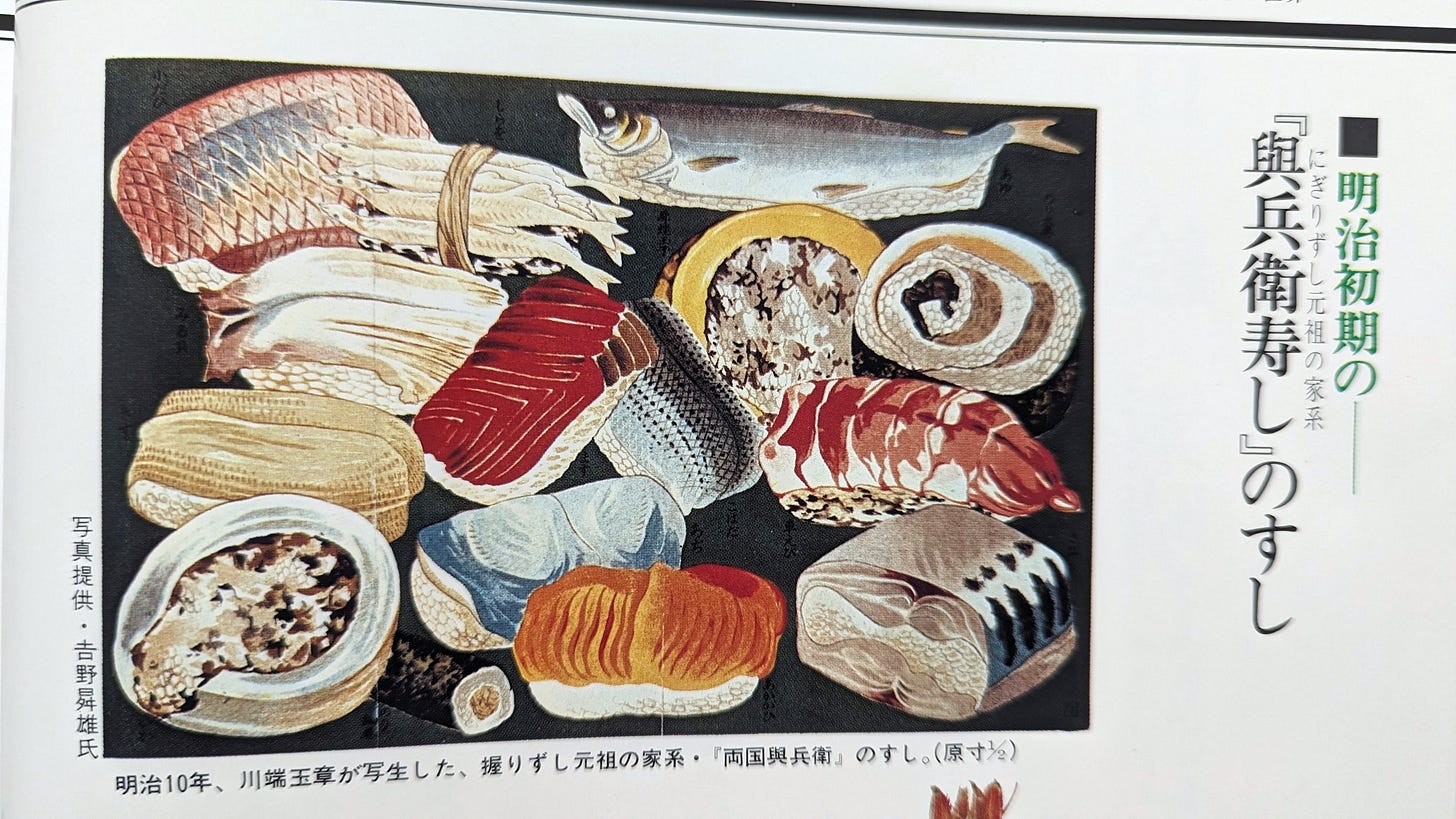Next to seasonings, I will explain the sushi ingredients. Many of you may be thinking, "I've been waiting for this!" In this chapter, we'll first introduce 37 traditional types of sushi, followed by 41 modern varieties that are commonly seen these days. Then, as a bonus, we'll show you how to order them a la carte when dining out. You may be surprised by the wealth of information covered. To begin, this article will organize historical background on the different styles of Edomae-zushi.
The most common types of sushi during the Edo period can be found documented in the book "Morisada-manko" (written by Morisada Kitagawa in the 1830s). This multi-volume work, published over about 30 years with a total of 35 volumes, is considered essential reading for understanding the customs of the Edo era.
▶Links to the Digital Collections of the National Diet Library
According to "Morisada-manko," after noting that nigirizushi became widely popular in the late Edo period (1603-1868), it lists the most common varieties at that time:
"The typical nigirizushi in Edo included: omelets, kuruma-ebi prawns, minced shrimp, shirauo, tuna, gizzard shad, and sweetened anago (conger eel)."
In other words, the most traditional sushi toppings were: egg omelet, kuruma-ebi prawn, shiba-ebi (tiny shrimp), shirauo(Japanese icefish), akami (lean tuna), kohada (gizzard shad), and anago.
Incidentally, it also mentions tempura items like: "anago, shiba-ebi, kohada, kobashira (adductor muscle of aoyagi clam), and surume (squid)." Interestingly, while kohada is listed as a tempura topping here, it is used exclusively as sushi today, not tempura. Vegetable tempura is very popular now, but that was not the case in the Edo period (1603-1867). As the saying goes, "Deep frying vegetables in oil was not considered tempura in Edo." During that era, tempura was strictly a seafood dish.
The next useful historical source is an 1877 (Meiji 10) painting of Yohei Sushi, the founder of Edomae-zushi, by artist Kawabata Gyokusho. This depiction shows the original varieties of Edomae-zushi.
The sushi toppings portrayed include: gizzard shad, sea bream, shirauo, sardine, mackerel, ayu, trout, horse mackerel, squid, aka-gai (red clam), miru-gai (keen's gaper), shrimp, datemaki (rolled omelet), futo-maki (kanpyo, shiba-ebi, shiitake mushroom) and hoso-maki rolls (with dried gourd).
Additionally, the annotations of renowned sushi chef Yoshino Yukio list other primary ingredients used at that time, such as: flounder, conger eel, octopus, various clam varieties (hamaguri, aka-gai, asari, aoyagi), abalone, and tuna. Regarding tuna (referred to as maguro), it was considered a relatively "modern" fish that gained popularity in the late Edo period. Needless to say, tuna has become a sushi staple beloved by people today, demonstrating how tastes evolve over time.
Also curiously omitted are some traditional sushi varieties like sea bream, bonito, striped marlin, spear squid, mantis shrimp, dried gourd strips, and oboro (shredded shiba-ebi shrimp) toppings. The "mako-garei", Flathead Flounder, is also missing, likely because flounder and other flatfish were not distinctly categorized during the Edo period (1603-1867). Two other important omissions are nori (seaweed sheets) and wasabi (Japanese horseradish) - though not toppings themselves, they are essential accompaniments that seem to have been overlooked. I will make sure to include these items in the comprehensive list.
37 Traditional Sushi Varieties
Red Sea Bream (Tai)
Young Sea Bream (Kasugo)
Flounder (Hirame)
Flathead Flounder (Mako-garei)
Trout (Masu)
Bonito (Katsuo)
Lean Tuna (Maguro Akami)
Striped Marlin (Makajiki)
Gizzard Shad (Kohada)
Young Gizzard Shad (Shinko)
Japanese Icefish (Shirauo)
Ayu
Japanese Sillago (Kisu)
Japanese Halfbeak (Sayori)
Horse Mackerel (Aji)
Mackerel (Saba)
Cuttlefish (Sumi-ika)
Young Cuttlefish (Shin-ika)
Kuruma-ebi prawn (Kurumaebi)
Egg Omelet (Tamago)
Nori Seaweed
Wasabi
Octopus (Tako)
Conger Eel (Anago)
Spear Squid (Yari-ika)
Mantis Shrimp (Shako)
Dried Gourd Strip (Kanpyo)
Shredded Shiba-ebi Shrimp (Oboro), Shiba Shrimp (Shiba-ebi)
Bloody Clam (Aka-gai)
Keen's Gaper (Miru-gai)
Rediated trough-shell (Aoyagi)
Adductor Muscle of Aoyagi clam (Kobashira)
Japanese Hard Clam (Hamaguri)
Japanese Short-neck Clam (Asari)
Egg-cockle (Tori-gai)
Pen-shell (Taira-gai)
Abalone (Awabi)
41 Modern Sushi Varieties
Japanese Seabass (Suzuki)
Blackfin seabass (Hirasuzuki)
Greater Amberjack (Kampachi)
Yellowtail Amberjack (Hiramasa)
Chicken Grunt (Isaki)
Spotted Halibut (Hoshi-garei)
Longtooth Grouper (Kue)
Green Ling (Ainame)
Red Bream (Kinme-dai)
Blackthroat Seaperch (Aka-mutsu)
Japanese Bluefish (Kuro-mutsu)
Filefish (Kawahagi)
Bartail Flathead (Kochi)
Spiny Red Gurnard (Houbo)
Japanese King Salmon (Masunosuke)
Summer-catch Salmon (Tokishirazu)
Chum Salmon (Keiji)
Biwako Trout (Biwa-masu)
Salmon
Medium-fatty Tuna (Maguro Chutoro)
Fatty Tuna (Maguro Otoro)
Yellowtail (Buri)
Sardine (Iwashi)
White Trevally (Shima-aji)
Spanish Mackerel (Sawara)
Barracuda (Kamasu)
Pacific Herring (Nishin)
Shishamo smelt (Shishamo)
Sea Urchin (Uni)
Salmon Roe (Ikura)
Queen Crab (Zuwai-gani)
Horsehair Crab (Kegani)
Bigfin Reef squid (Aori-ika)
Firefly Squid (Hotaru-ika)
Pink Shrimp (Ama-ebi)
Botan Shrimp (Botan-ebi)
White Shrimp (Shiro-ebi)
Monkfish Liver (Ankimo)
Scallop (Hotate-gai)
Hen-clam (Hokki-gai)
Oyster (Kaki)
I hope you're looking forward to my next article!
If you enjoy this article, please share it on your social networks. Your support inspires me to keep writing!
The TOC of “Spirits of Sushi“
The History of Sushi
Exploring Sushi Varieties: Edomae-zushi (Nigiri-zushi), Kansai-zushi, and More
Essential Sushi Vocabulary: Key Terms for Navigating a Sushi Restaurant
The Heart of Sushi: A Guide to “Shari”, Sushi Rice
A Deep Dive into Sushi Fish and Accompaniments
The Art of the Sushi Master: Traditional Japanese Knives
Japan's Exquisite Fish Culture: From Tsukiji to Toyosu Market and Various Regions
Must-Visit Sushi Restaurants: From Tokyo to Sapporo, Fukuoka, and Other Regions
Regional Sushi Styles: Exploring Japan's Diverse Sushi Culture
Sushi and Sake Pairings: A Culinary Adventure
Sushi Etiquette and Table Manner: Dining like a Sophisticated Local
Shopping in Japan: Essentials for Crafting Delicious Sushi at Home
Sushi in Pop Culture: Manga and Movies
Sushi: A Lens on Health and Sustainability
Wrapping Up: The Future of Sushi







